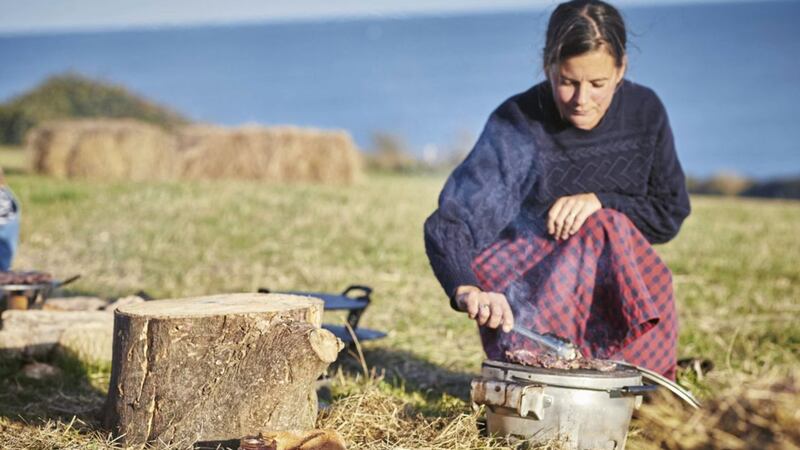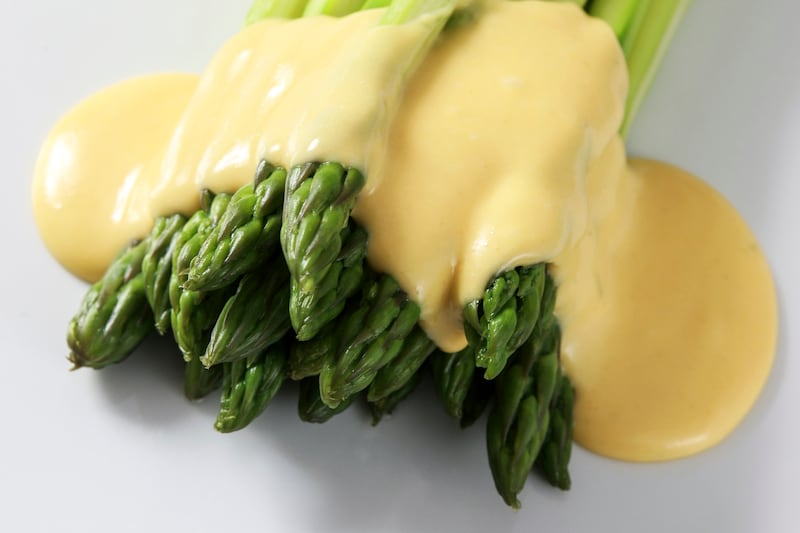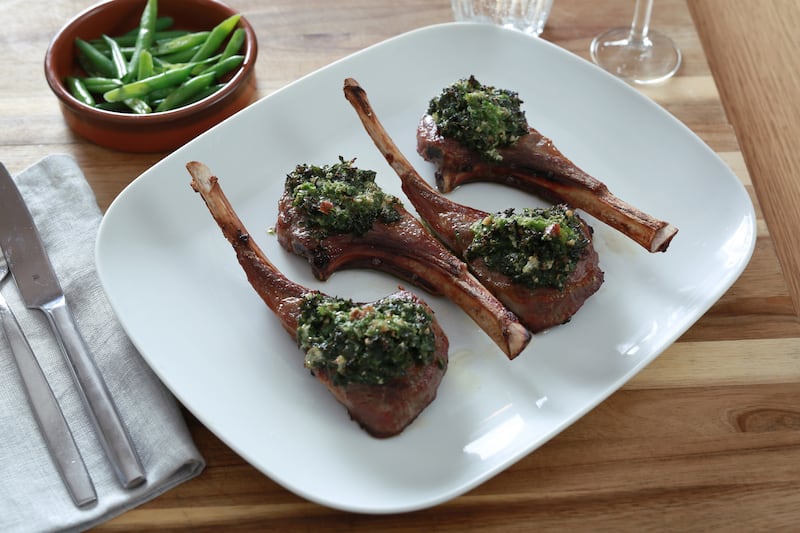AS WE face another summer where overseas travel isn’t particularly easy, many of us will be exploring closer to home.
Chefs Claire Thomson and Matt Williamson are ahead of the curve; long before Covid put a stranglehold on travelling abroad, the duo were gallivanting around the country with their three daughters in a VW camper van – and whipping up delicious meals on the way.
Thomson and Williamson are well aware that food on camping holidays often has a pretty dodgy reputation. “People think, ‘Oh, it’s just baked beans and it’s really difficult to cook’,” says Thomson with a groan. “I personally hate baked beans, couldn’t bear to eat them.”
Williamson acknowledges there’s a “misconception that everything kind of needs to come out of a jar or out of a packet when you’re camping”. He admits “there’s a place” for easy, quick camping meals, such as instant noodles or Thomson’s dreaded baked beans, but that’s not the kind of food they eat on holiday – and it’s not the meals you’ll find in their latest cookbook, Camper Van Cooking.
For Thomson, this is actually the “easiest cookbook” she’s written (previous publications include Home Cookery Year and New Kitchen Basics). “All the other cookbooks are a bit more elaborate, because you’re at home and you’ve got all your ingredients,” she explains. “You’ve got four, five burners on your oven… [Whereas] this is one pot, it’s primal cookery, how to make food really easily with fire, or over a little gas stove.”
As a Kiwi, Williamson spent his childhood camping and grew up on fresh, delicious holiday food. “My dad’s a butcher and a lot of his friends were quite into food, and we’d usually go to areas with a bit of fishing,” he reminisces. “Dinners were great: usually cooked over fire and barbecue.”
Thomson didn’t have the same upbringing, admitting she “wasn’t a camper – I only started camping when we got together”. However, she swiftly fell in love with it – particularly with their three children in tow. If you “go check into a hotel, it’s just a bit stifling for kids”, she says. “It’s much better to have that roaming about, free run existence of camping”.
That’s not to say she hasn’t experienced her fair share of hiccups. “I managed to leave all our shoes in a box last year and it rained – like deluged with rain – and we had wet shoes for the rest of the holiday,” she says, with palpable regret.
But for both, all the potential pitfalls of camping (Williamson admits it can be “awful” when it rains), are completely forgotten come dinnertime. “Pretty much the first thing we think about going camping, is what we’re going to eat,” says Williamson.
Thomson adds: “I love the food angle of cooking outside. I love the evenings and the conviviality of meeting new people. It’s always that nice energy around teatime, when you’re bumping into people on the campsite and the kids make new friends – I like that freedom.”
For Thomson, the key to a good campsite meal is coming prepared with store cupboard staples, and looking to what’s on offer in the local area. “By the sea, you might buy some fresh fish, or inland you might head to the farm shops, or in Cornwall all the little roadside vegetable stalls they have with honesty boxes,” she says. “I’ll cook anything, but we’ll always look to where we are to what we’re cooking.”
Getting everything together for a camping holiday might seem daunting: there’s so much you need to think about and remember. Williamson says: “Our backgrounds are in restaurants, and my approach to being in a restaurant is, if you’ve got everything ready, life’s really easy – and cooking is really easy and fun. With camping, everything takes twice as long, so having everything to hand just makes it so much more relaxing.”
“In restaurants, it’s called ‘mise en place’,” Thomson chimes in, “when you have all your stuff in place, [ready] to go. And that is camping.”
As much as he prizes organisation, Williamson says: “At the same time, if something is missing, you just roll with it. Because who wants to go running off to try find some ingredients? Having a degree of flexibility, along with being organised, is just as important.”
After all, this is your holiday – and food is meant to be a joyous experience, not a trial. “It’s part of the evening’s entertainment, cooking the dinner,” says Thomson. “It’s part of the rhythm of the night.”
She admits the holidays they do – in a luxurious VW camper van – are “fairly aspirational”, but these recipes suit any type of camping, catering to all levels of equipment and skills. “There’s a romance to camping,” Thomson adds with a longing sigh – no doubt imagining the family’s next adventure.
Camper Van Cooking by Claire Thomson & Matt Williamson is published by Quadrille, priced £20. Photography by Sam Folan. Available now. Below are three recipes for you to try at home...
TOASTED WAFFLES RECIPE, WITH GRATED DARK CHOCOLATE AND COCONUT YOGHURT
(Serves 4)
100g dark or milk chocolate (a large bar), coarsely grated
8 waffles
About ¾ cupful coconut yoghurt (about 200g)
Method:
1. Divide the chocolate into four portions at the ready.
2. Toast the waffles, over a grill or in a dry frying pan over a moderate heat, until warm and golden. Transfer the waffles to four serving plates (two waffles each).
3. Immediately sprinkle one of the portions of grated chocolate over each serving, repeating until all the waffles have a melty chocolate topping. Divide the coconut yoghurt between the four servings and tuck in immediately.
FRIED MACKEREL RECIPE, WITH HORSERADISH BUTTER, GHERKINS AND LETTUCE IN BRIOCHE BUNS
(Serves 4)
4tbsp butter, softened
2–4tbsp horseradish, to taste
4 large or 8 small mackerel fillets
1 soft round lettuce, leaves separated
4 large gherkins, sliced
Salt and black pepper
4 brioche buns (or any soft roll), split open, to serve
Method:
1. Beat the butter and horseradish together in a bowl, adding pepper to taste, then put the mixture to one side.
2. Season the mackerel fillets on both sides and grill them over a high heat, skin-side down, for two minutes. Carefully flip the fillets over with a spatula and cook for another one minute, until just cooked through. (Cook in a pan with a splash of cooking oil, if you prefer.)
3. Lightly toast the inside of the rolls on the grill, then generously spread each with the horseradish butter. Add lettuce and gherkins to each bun, then finally the cooked mackerel, sandwiching shut to serve.
LAMB AND DATE TAGINE
(Serves 4)
50g butter or 50ml olive oil
600g lamb (shoulder is best), cut into 3cm dice
1tsp salt, plus more if needed
1 x 400g can of chopped tomatoes
2 onions, finely chopped
3 garlic cloves, finely chopped
½tsp chilli flakes, or more to taste
2tsp cumin seeds, toasted and ground
2tsp coriander seeds, toasted and ground
1tsp ground turmeric
1½tsp ground ginger
1 cinnamon stick
1 small orange or 1 lemon, 2 small strips of zest removed and reserved
2tbsp runny honey
16 dates, pitted, or 12 dried apricots
Black pepper
To serve:
50g whole almonds, chopped
Couscous, cooked as per the packet instructions
Method:
1. Melt half the butter in a small saucepan, then transfer it (or half the olive oil) to a large bowl and mix it together with the lamb, salt, tomatoes, onions, garlic and all of the spices. Cover and leave refrigerated for at least a couple of hours – overnight is ideal.
2. To cook, put the marinated meat in a large heavy-bottomed saucepan. Add the remaining butter or oil and cook the meat over a moderate–low heat, uncovered, for 20 minutes, stirring from time to time.
3. Meanwhile, halve the orange or lemon, squeezing and reserving the juice from one half and reserving the remaining half to cut into wedges later, to serve.
4. After 20 minutes, add 400ml of water to the saucepan, along with the honey, orange or lemon zest and the juice, and the dates or apricots. Stir to combine and reduce the heat to low, then cover and simmer very gently for about one to one and a half hours, or until the meat is melting and tender. Check the tagine from time to time to ensure it doesn’t catch, adding a splash more water to the pan if you think it needs it.
5. Check the seasoning, adjusting with salt and pepper to taste – you want a heady mix of savoury, sweet and spice, with the lamb and its sauce in perfect balance. Refrigerate, or freeze, to take camping.
6. To serve, heat the tagine over a moderate heat until piping hot and serve topped with the almonds with couscous and orange or lemon wedges on the side.








